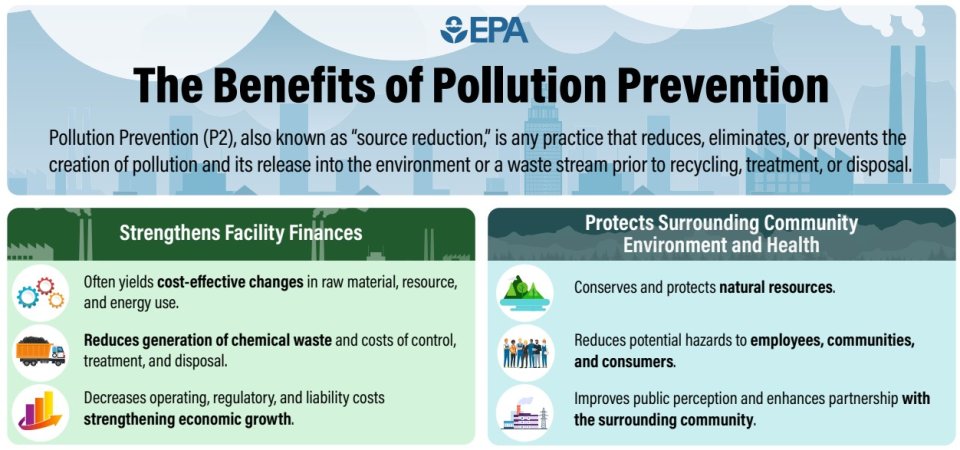Pollution Prevention (P2) and TRI

Under the Pollution Prevention Act of 1990 (PPA), the Toxics Release Inventory (TRI) Program collects information to track industry progress in reducing chemical waste generation and moving towards safer waste management alternatives. Many facilities describe measures they have implemented to prevent pollution from chemicals and reduce the amount of chemicals entering the environment. As a result, TRI serves as a tool for identifying effective environmental practices and highlighting pollution prevention successes.
Access TRI's P2 Data
- Use the TRI P2 Search Tool to get info by industry sector, chemical, geography or parent company, and compare environmental performance.
- Use the TRI Toxics Tracker to explore TRI information and quickly filter by industry sector, type of source reduction activity, and other variables.
Learn About TRI P2 Resources
- Browse P2 analyses and publications for information on P2 opportunities and the benefits of implementing P2 at facilities.
- Browse TRI's collection of P2 resources, including factsheets, videos, tips for reporting P2 activities to TRI, and how-to guidance for conducting analyses with the TRI P2 Search Tool.
In 2023, 1,770 facilities (8% of all facilities that reported to TRI) implemented a combined 3,690 new source reduction activities. Click on the legend or graph to see examples of source reduction activities. Reported codes are included in parentheses.
P2 Examples
The S codes in parentheses following each example represent a type of source reduction activity. Refer to Appendix A of the P2 Reporting Guide for an explanation of the S codes.
Process and Equipment Modifications
- A medicinal product manufacturer removed portions of an ammonia system that was no longer in use, increasing the efficiency of the delivery system and reducing the amount of ammonia used and generated as waste. (S21)
- A resin compounding facility reused bronze-filled materials lost during production, recapturing copper-containing material that would have otherwise been managed as waste. (S22)
Operating Practices and Training
- A paint and coating manufacturer improved the way it scheduled campaigns to minimize washouts between batches, reducing the amount of ethylbenzene managed as waste. (S43)
- A household appliance manufacturer trained painters in methods for more efficient, consistent and accurate painting which resulted in improved coverage, reducing the amount of toluene managed as waste. (S44)
Inventory and Material Management
- A gravure printing facility completed projects in 2023 that prevented leaks and failures in the coating lines, reducing the amount of toluene that would have been managed as waste. (S33)
- A motor vehicle part manufacturer improved diisocyanate material management by installing temperature sensors that alert personnel if the material storage area is outside of an acceptable temperature range. (S34)
Material Substitutions and Modifications
- A rubber product manufacturer replaced the ammonia used as a manufacturing aid with a non-TRI chemical, eliminating almost all ammonia from its manufacturing process. (S04)
- A metal parts manufacturer that works with vehicle manufacturers reports that it now sources steel and other raw materials with a lower lead content. (S05)
Product Modifications
- A film components manufacturer introduced an alternative formulation that reduces the amount of zinc compounds used in thermal production. (S11)
- A irradiation equipment manufacturer redesigned the lead shielding component in its product, replacing a lead part that had to be removed and managed as waste with a permanent part. (S12)
